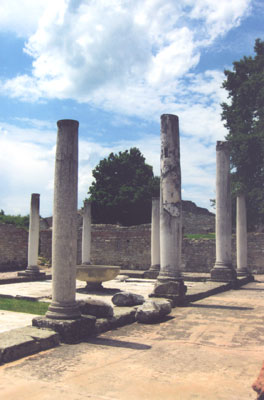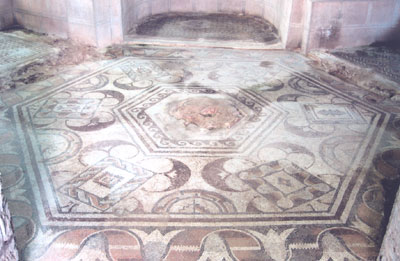Romans in Serbia
This item appears on page 60 of the October 2011 issue.
(First of three parts)
Of the many Roman emperors who ruled between the first century BC and the sixth century AD, it is extraordinary to me that 17 of them were born in what is now Serbia.
Five years ago my husband, Paul, and I visited Croatia, Slovenia and Bosnia, three of the seven countries that once were Yugoslavia. We wanted to travel to the remaining four: Serbia, Macedonia, Kosovo and Montenegro.
We selected Bestway Tours & Safaris to put together a customized private tour of 20 days for May-June 2011 that would include the highlights of these four Balkan countries. Bestway did an admirable job.
Serbia, the first country we visited on this trip, was of great interest to me because of its rich Roman heritage. As Rome pushed its frontiers eastward 2,000 years ago, it established fortresses along a route that stretched from Rome to Byzantium. Right behind the Roman soldiers came merchants and artisans, and soon the fortresses developed into towns.
In a period of about 200 years — roughly the mid third to mid fifth centuries AD — what once was Rome’s frontier became if not the center of the empire then something very close to it, often serving as temporary administrative centers. In the course of our 10 days in Serbia, we were to visit five Roman sites.
A capital of the Roman Empire
The first site was Sirmium, now largely covered by the modern city of Sremska Mitrovica, 36 miles northwest of Belgrade, Serbia’s capital.
One has to look only at the on-site model of Sirmium to realize how important a city it was to the Romans. It was, in fact, one of the four capitals of the Roman Empire after Diocletian’s partition in AD 395.
Sirmium was physically dominated by a huge hippodrome, reputedly one of the largest in the Roman world, now lying unexcavated beneath the modern city.
Adjacent to the hippodrome stood an equally large imperial palace with extensive residential and administrative sections. It is thought that Marcus Aurelius, Diocletian and Septimius Severus each may have lived there. The city also had an aqueduct, baths, temples and a granary, with walls enclosing them all.
Today visitors can walk through a portion of the imperial palace, now covered by a protective dome. Mosaic floors, fragments of frescoed walls and sections of under-floor heating all are still visible.
The Huns conquered Sirmium in AD 441. The Avars destroyed it in AD 582, although it was revived in subsequent centuries by Byzantines, Serbs and Ottoman Turks.
In the opposite direction from Belgrade lies Viminacium, 43 miles southeast of the capital. Founded as a military camp near the Danube in the first century AD, Viminacium became a municipium, a city with a high degree of autonomy, during the reign of Hadrian (AD 117-138) before finally becoming a colony in 239, the highest status a municipium could achieve within the Roman Empire.
Huge necropolis
Viminacium’s importance is attested to by the size of its necropolis. Over 13,000 graves and sarcophagi have been discovered so far. Some of these — a few with occupants still inside — can be seen in an enclosed protected area.
There are also fourth-century-AD underground crypts with frescoes still intact that can be visited on brief tours offered periodically throughout the day. It’s a unique opportunity. Also visible nearby are the thermae, baths, of the ancient city.
As with Sirmium, Viminacium was overrun by Huns in the mid fifth century AD and by Avars in the late sixth century AD.
Where Belgrade now stands was Singidunum, located between Sirmium and Viminacium. Built as a military camp at the confluence of the Danube and Sava rivers, it too became a municipium and later a colony.
There is little that remains to be seen of Singidunum today, except for artifacts housed in museums, although it is popularly believed that the deep well at Belgrade Fortress on Kalemegdan Hill overlooking the Danube was used by the Romans 2,000 years ago.
An emperor’s retirement palace
In addition to the Roman towns, we also visited two imperial villas. The first is a UNESCO World Heritage Site, Felix Romuliana, located near Zaječar in eastern Serbia.
Emperor Gaius Valerius Galerius Maximianus (Galerius, for short), who ruled from AD 293 to 311, began building Romuliana at the end of the third century AD. He named the complex in honor of his mother and intended to use it as his retirement home.
What a complex it is. Measuring 1,000 feet by 760 feet and enclosed by walls punctuated by 20 towers and two gateways, Romuliana looks more like a small city than a palace.
Visitors can stroll through the public sections of the complex with remnants of public baths and walk around the base of a gigantic temple to Jupiter as well as explore the formal section where the emperor received guests and the private area where Galerius actually lived.
Galerius and his mother now rest in mausoleums on twin hills overlooking the palace complex. The Huns plundered the palace in AD 441.
An emperor’s summer palace
The second villa we visited was in Niš, 60 miles south of Romuliana. Niš, called Naissus in Roman times, was the birthplace of Constantine the Great around AD 274.
In Naissus’ suburb, Mediana, a large villa from the early-fourth century, has been excavated. It is speculated that this may have been Constantine’s summer residence. This villa had a garden with a pool in its center and was surrounded by a peristyle.
Most interesting is a small room near the villa’s triclinium, or dining room, with four niches around a hexagonal central portion with a fountain. The floor is covered with geometrical and floral mosaics. Our guide told us that the room was intended for private discussions, with the sound of the burbling fountain making it difficult for eavesdroppers to listen in on conversations.
Constantine is best known for issuing the Edict of Milan, in AD 313, in which Christianity was given equal status with the other religions of the Roman Empire.
As with the other Serbian Roman sites, Huns marauded in the fifth century AD and Avars in the sixth century.
Monasteries and beauty
Serbia wasn’t just about Roman ruins, wonderful as they were. It’s a country with so much to offer interested travelers.
This is just a sampling of my favorites: the two UNESCO World Heritage Site monastery complexes of Studenica and Sopoćani; ethno villages with great charm and scenic beauty, especially Sirogojno; the cafés of Belgrade; spectacular mountain scenery, and the fabulous Hotel Leopold I, occupying a 17th-century fortress high above the Danube in Novi Sad — all reasons to visit, and soon before all the other tourists arrive.
If you go…
Our private tour, with a driver/guide, included Serbia, Macedonia, Kosovo and Montenegro. Half of our 20 days was spent in Serbia.
Arrangements were made by Bestway Tours & Safaris (8678 Greenall Ave., Ste. 206, Burnaby, BC, Canada V5J 3M6; 800/663-0844 [toll-free in US & Can.] or 604/264-7378). Bestway has 33 years of experience planning both customized trips and group tours to destinations around the world.
For those interested in group travel, the company offers “Balkan Mosaic,” a 20-day tour to eight Balkan countries. This tour is offered twice each year, in May and September, and prices, excluding airfare, currently range from $6,070 to $7,875, depending on the number of participants (two to 14).
In future issues, we’re on to Macedonia, Kosovo and Montenegro.


